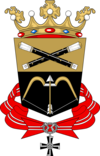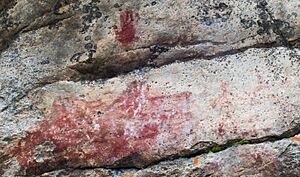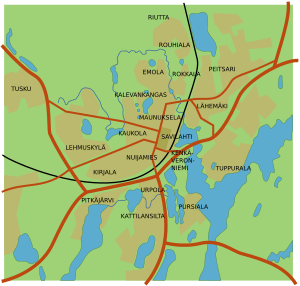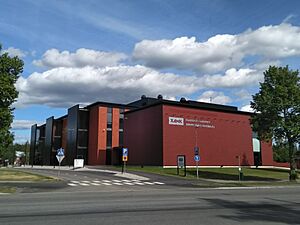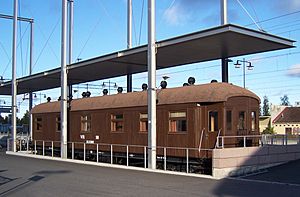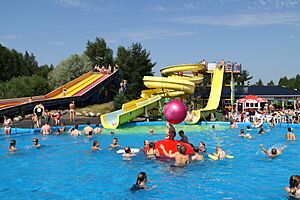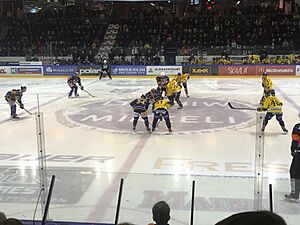Mikkeli facts for kids
Quick facts for kids
Mikkeli
S:t Michel
|
||
|---|---|---|
|
Town
|
||
| Mikkelin kaupunki S:t Michels stad |
||
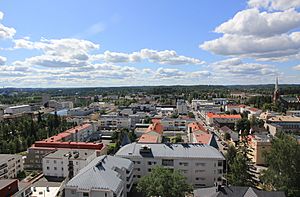 |
||
|
||
| Country | Finland | |
| Region | Etelä-Savo | |
| Sub-region | Mikkeli | |
| Charter | 1838 | |
| Government | ||
| • Type | Council-manager | |
| • Body | City Council | |
| Area
(2018-01-01)
|
||
| • Total | 3,229.57 km2 (1,246.94 sq mi) | |
| • Land | 2,548.35 km2 (983.92 sq mi) | |
| • Water | 424.7 km2 (164.0 sq mi) | |
| Area rank | 23rd largest in Finland | |
| Population
(2023-12-31)
|
||
| • Total | 51,919 | |
| • Rank | 18th largest in Finland | |
| • Density | 20.37/km2 (52.8/sq mi) | |
| Population by native language | ||
| • Finnish | 94.4% (official) | |
| • Swedish | 0.2% | |
| • Others | 5.4% | |
| Population by age | ||
| • 0 to 14 | 13.9% | |
| • 15 to 64 | 58.9% | |
| • 65 or older | 27.2% | |
| Time zone | UTC+02:00 (EET) | |
| • Summer (DST) | UTC+03:00 (EEST) | |
| Website | www.mikkeli.fi | |
Mikkeli is a city in Finland and the main city of the South Savo region. It's located in the Finnish Lakeland, an area famous for its many lakes. About 52,000 people live in Mikkeli. This makes it one of the largest cities in Finland.
Mikkeli sits on the shores of Lake Saimaa, which is a huge lake system. The city was once part of the Mikkeli Province until 1997. It then became part of the Eastern Finland Province until 2009. Mikkeli covers a large area, with much of it being water.
During World War II, Mikkeli was a very important place. It was the main headquarters for the Finnish Defence Forces. Because of this, the city's coat of arms has two crossed batons, which are like symbols of military leadership. The city also received a special award called the Cross of Liberty.
Contents
History of Mikkeli
The first signs of people living in the Mikkeli area are the Astuvansalmi rock paintings. These paintings are found in Ristiina and are super old, dating back to 4100-2000 BCE. They are the biggest collection of rock paintings in all the Nordic countries!
The area of Mikkeli was first mentioned in a peace agreement in 1323. This agreement moved the local church area, called a "pogost," from Novgorod to Sweden. The name Mikkeli comes from Archangel Michael and was used by the early 1500s.
In 1597, a sad event happened during the Cudgel War. More than 200 peasant rebels were killed in Kenkävero. Later, in 1789, a battle called the Battle of Porrassalmi took place near Mikkeli. The Swedes (who included Finns) won against a larger Russian army.
Mikkeli officially became a town in 1838. The government for the province moved to Mikkeli in 1843.
Mikkeli During Wars
In 1918, during the Finnish Civil War, Mikkeli became the headquarters for the White Army. The city was a strong base for them. A big fight happened near Mäntyharju when the White Army stopped a Red Army attack.
During the Winter War and Continuation War (parts of World War II), Mikkeli was again the main headquarters for the Finnish Army. The army staff worked from a local school. Today, that school site has a small museum called the Päämajamuseo (Finnish for 'Headquarters Museum'). It shows photos and items from that time. Mikkeli was bombed a lot during the war because it was so important. However, the damage was quickly fixed.
Marshal C. G. E. Mannerheim was the supreme commander of the Finnish Defence Forces during the war. He later became President of Finland. His special railway carriage, which he used as his command center, is still parked at Mikkeli Station. You can look inside through the windows anytime. Once a year, on his birthday (June 4), you can go inside. This carriage was where Mannerheim famously met Adolf Hitler in 1942.
One of the main museums in Mikkeli is the Jalkaväkimuseo (Finnish for 'Infantry Museum'). It's in an old army building. This museum shows items from Finland's four modern wars: the Civil War, Winter War, Continuation War, and Lapland War. It also has a special display about Finnish war hero Lauri Törni.
In 1997, Mikkeli became the capital of the new province of Eastern Finland. Over the years, several smaller towns and areas like Anttola, Haukivuori, Ristiina, and Suomenniemi joined with Mikkeli.
Geography
Mikkeli's center is on a small hill near a bay of Lake Saimaa. There are many small lakes in and around the city. Some lakes in the east are part of the River Vuoksi system. To the west, the city reaches Lake Puula, which is part of the River Kymijoki system.
Population in Mikkeli
Mikkeli has about 51,919 people. This makes it the 18th most populated city in Finland. The Mikkeli region, which includes nearby areas, has about 68,302 people.
About 5.5% of the people in Mikkeli have a foreign background. This is a bit lower than the average for all of Finland. The city's population density is about 20.37 inhabitants per square kilometre (52.8/sq mi).
| Year | Population |
|---|---|
| 1990 |
54,404
|
| 1995 |
55,563
|
| 2000 |
55,222
|
| 2005 |
54,728
|
| 2010 |
54,455
|
| 2015 |
54,665
|
| 2020 |
52,583
|
Languages Spoken
Population by mother tongue (2023) Finnish (94.4%) Russian (1.4%) Ukrainian (0.5%) Arabic (0.4%) Estonian (0.3%) Farsi (0.3%) English (0.2%) Other (2.4%)
Most people in Mikkeli speak Finnish as their first language. About 49,022 people, or 94.4% of the population, speak Finnish. A small number of people, 87 or 0.2% of the population, speak Swedish.
About 5.4% of the people in Mikkeli speak a language other than Finnish or Swedish as their first language. Since English and Swedish are taught in schools, many people can speak more than one language.
At least 30 different languages are spoken in Mikkeli. The most common foreign languages are Russian (1.4%), Ukrainian (0.5%), Arabic (0.4%), and Estonian (0.3%).
People from Other Countries
| Population by country of birth (2022) | ||
| Nationality | Population | % |
|---|---|---|
| 49,928 | 95.5 | |
| 427 | 0.8 | |
| 254 | 0.5 | |
| 134 | 0.3 | |
| 107 | 0.2 | |
| 102 | 0.2 | |
| 86 | 0.2 | |
| 82 | 0.2 | |
| 65 | 0.1 | |
| 61 | 0.1 | |
| 60 | 0.1 | |
| Other | 974 | 1.8 |
As of 2023, about 2,855 people in Mikkeli have a background from another country. This is about 5.5% of the population. Most foreign-born people came from the former Soviet Union, Russia, Estonia, and Thailand.
The number of new residents from other countries is growing. This means the percentage of foreign residents will likely increase in the future.
Religions
In 2023, the Evangelical Lutheran Church was the largest religious group in Mikkeli. About 71.4% of the people belonged to this church. Other religious groups made up 1.9% of the population. A significant part of the population, 26.7%, did not belong to any religious group.
Education in Mikkeli
Mikkeli is home to a main campus of the South-Eastern Finland University of Applied Sciences (Xamk). This university is a big employer in the city. It started in 1965 as a college for professional and engineering studies. The first students began in 1969 in old army buildings. New buildings have been added, but the old ones are still used.
Several other universities also have a presence in Mikkeli. The Mikkeli University Consortium includes parts of the University of Helsinki, Aalto University, University of Eastern Finland, and Lappeenranta University of Technology. Aalto University offers a highly-rated Bachelor of Science degree in international business, which is taught in English and attracts students from all over the world.
Getting Around Mikkeli
Mikkeli has good road connections to the Helsinki metropolitan area through national roads 5 and 4. The city has a railway station on the Savonia railway. Five trains travel to and from Helsinki every day. There are also bus connections to nearby cities and towns, and a local bus network within Mikkeli. Mikkeli also has its own airport, but it hasn't had regular passenger flights since 2005.
Culture in Mikkeli
Mikkeli has its own concert hall, which was built in 1988 to celebrate the city's 150th anniversary. This concert hall is home to the St. Michel Strings orchestra. It's also the main place for the yearly Mikkeli Music Festival, which brings musicians and audiences from all over Europe. The Mariinsky Opera group often performs there.
Tourism in Mikkeli
Mikkeli is a popular place for holidays in the Finnish lakeland area. A well-known theme park called Visulahti is in Mikkeli, right on the shores of Lake Saimaa. Mikkeli is also popular for summerhouses because of its many lakes. In 2020, there were over 10,000 summerhouses in Mikkeli, which is the second most in Finland. This means the population grows a lot during the summer! Much of the tourism here is about enjoying nature and the lakes.
Because Mikkeli was the headquarters during World War II, the city has several museums about that time. These include the Infantry Museum, the Lokki Communications Center, and the Headquarters Museum.
The yearly horse racing event, St Michel ravit, is Mikkeli's biggest event. It attracts about 20,000 people.
Most hotels are in the center of Mikkeli. In other areas, you can find rental cottages in smaller villages and the countryside.
Sports in Mikkeli
Jukurit is Mikkeli's ice hockey team. They play in Finland's top league, Liiga. The team has won the Mestis (the second-highest league) championship six times.
Mikkelin Kampparit is a bandy team that plays in the highest bandy division. In 2012, they won the Finnish championship for the first time.
Mikkeli has two main football teams: Mikkelin Palloilijat (MP) and Mikkelin Pallo-Kissat (MiPK). Both teams have played in Finland's top football league. Currently, MP plays in the second-highest league, and MiPK plays in the third-highest. Olli Rehn, who used to be an EU commissioner, played for MP for 13 years!
Famous People from Mikkeli
- Manuela Bosco
- Jussi Jääskeläinen
- Jari Ketomaa
- Harri Kirvesniemi
- Mikko Kolehmainen
- Olli Kolehmainen
- Shefki Kuqi
- Erkki Liikanen
- Otto Manninen
- Mikko Tarmia
- Arja Saijonmaa
- Olli Rehn
Mikkeli's Sister Cities
Mikkeli has "twin towns" or "sister cities" around the world. These are cities that have special friendly relationships with Mikkeli.
|
See also
 In Spanish: Mikkeli para niños
In Spanish: Mikkeli para niños


